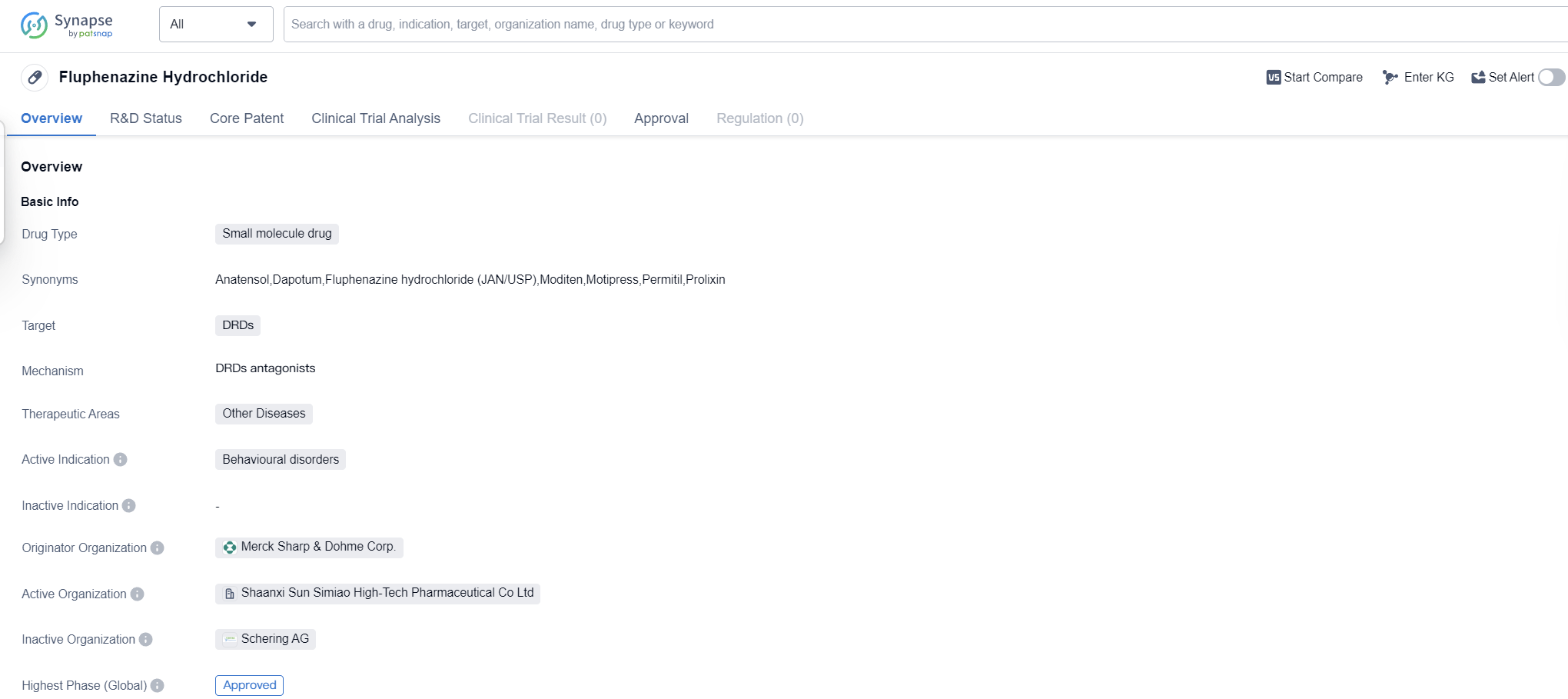Pharmaceutical Insights: fluphenazine hydrochloride's R&D Progress and its Mechanism of Action on Drug Target
Fluphenazine hydrochloride's R&D Progress
Fluphenazine Hydrochloride is a small molecule drug that falls under the therapeutic area of other diseases in the field of biomedicine. It primarily targets DRDs (Dopamine Receptors) and is indicated for the treatment of behavioral disorders. The drug was first approved in the United States in September 1959 and has since gained approval in other countries as well.
The originator organization of Fluphenazine Hydrochloride is Merck Sharp & Dohme Corp., a renowned pharmaceutical company. The highest R&D phase of this drug is approved.
As a small molecule drug, Fluphenazine Hydrochloride is designed to interact with dopamine receptors in the brain. Dopamine receptors play a crucial role in regulating various neurological functions, including mood, behavior, and cognition. By targeting these receptors, Fluphenazine Hydrochloride aims to modulate dopamine levels and alleviate symptoms associated with behavioral disorders.
Behavioral disorders encompass a wide range of conditions characterized by abnormal or disruptive behaviors. These may include conditions such as schizophrenia, bipolar disorder, and other psychiatric disorders. Fluphenazine Hydrochloride is prescribed to manage symptoms such as hallucinations, delusions, aggression, and agitation commonly associated with these disorders.
The approval of Fluphenazine Hydrochloride in 1959 marked a significant milestone in the treatment of behavioral disorders. Since then, it has been widely used as a therapeutic option for patients suffering from these conditions. The drug's approval in both the United States and China highlights its global recognition and acceptance in the medical community.
👇Please click on the image below to directly access the latest data (R&D Status | Core Patent | Clinical Trial | Approval status in Global countries) of this drug.
Mechanism of Action for fluphenazine hydrochloride: DRDs antagonists
DRDs antagonists refers to dopamine receptor antagonists. Dopamine is a neurotransmitter in the brain that plays a crucial role in various physiological functions, including movement, reward, motivation, and mood regulation. Dopamine receptor antagonists are a class of drugs that block the action of dopamine at its receptors.
From a biomedical perspective, DRDs antagonists are commonly used in the treatment of psychiatric disorders such as schizophrenia and bipolar disorder. By blocking dopamine receptors, these antagonists help to reduce the excessive dopamine activity in certain regions of the brain, thereby alleviating symptoms associated with these disorders.
DRDs antagonists can have different selectivity for the specific subtypes of dopamine receptors, such as D1, D2, D3, D4, and D5 receptors. Depending on the subtype targeted, these antagonists may have varying effects on different physiological and pathological processes.
It is important to note that the use of DRDs antagonists should be carefully monitored and prescribed by healthcare professionals, as they can have potential side effects such as sedation, movement disorders, hormonal imbalances, and cardiovascular effects.
Drug Target R&D Trends for fluphenazine hydrochloride
DRDs, or dopamine receptors, play a crucial role in the human body. These receptors are found in various regions of the brain and are responsible for transmitting signals related to dopamine, a neurotransmitter involved in regulating mood, motivation, and movement. DRDs are categorized into different subtypes, such as D1-like and D2-like receptors, each with distinct functions. Activation or inhibition of these receptors can have significant effects on behavior, cognition, and overall mental health. Understanding the role of DRDs is essential in developing pharmaceutical interventions targeting dopamine pathways, which can be utilized in the treatment of various neurological and psychiatric disorders.
According to Patsnap Synapse, as of 16 Sep 2023, there are a total of 579 DRDs drugs worldwide, from 482 organizations, covering 250 indications, and conducting 5445 clinical trials.
Overall, the target DRDs present a promising landscape for the pharmaceutical industry, with opportunities for growth and innovation. Companies and countries/locations that invest in research and development, clinical trials, and regulatory compliance are likely to succeed in this competitive market.
👇Please click on the picture link below for free registration or log in directly if you have a freemium account, you can browse the latest research progress on drugs, indications, organizations, clinical trials, clinical results, and drug patents related to this target
Conclusion
In summary, Fluphenazine Hydrochloride is a small molecule drug developed by Merck Sharp & Dohme Corp. It targets dopamine receptors and is indicated for the treatment of behavioral disorders. With its approval in multiple countries, including the United States and China, Fluphenazine Hydrochloride has established itself as an important therapeutic option for patients suffering from these conditions.






